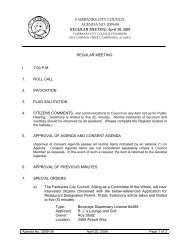J Dent Res 86(5) 2007 <strong>Fluoride</strong> Affects <strong>Adults</strong> 413Eleven studies examined theeffectiveness of self- or clinicallyapplied fluoride. Of these studies, 10were r<strong>and</strong>omized clinical trials, <strong>and</strong> 1was a controlled trial (split-mouth)that did not specify whether thetreatment had been r<strong>and</strong>omly assigned.Nine studies examined theeffectiveness of water fluoridation—one was a prospective cohort trial thatexamined caries increment amongr<strong>and</strong>omly selected lifelong residents offluoridated <strong>and</strong> non-fluoridatedcommunities, <strong>and</strong> 8 were crosssectionalstudies. In this last group, 7compared caries prevalence betweenlifelong residents of fluoridated <strong>and</strong>non-fluoridated communities, <strong>and</strong> 1used linear regression analysis toestimate averted caries incrementattributable to 1 yr of exposure towater fluoridation. Among the 12longitudinal studies, 9 reported thedrop-out rate (mean drop-out rate forone yr [weighted by sample size] =10.9%), 5 reported that examinerswere blinded, <strong>and</strong> 8 reported using aplacebo.Is Any <strong>Fluoride</strong> Effective in Preventing Caries?Table 2. P Values for Combined ResultsEighteen studies (11,649 participants) compared coronal cariesamong adults of all ages by fluoride exposure (Table 2). Carieswas always higher in the control group than in the treatmentgroup. With Fisher's inverse chi-square method, the combined p-values were less than 0.001. Six studies (2290 participants)compared coronal caries among adults aged 40+ yrs. Again,caries was always higher in the control group than in thetreatment group, <strong>and</strong> the combined p-values were less than0.001. Finally, 7 studies (2112 participants) compared root cariesamong adults aged 40+ yrs by fluoride exposure (Table 2); in allstudies, caries was higher in the non-fluoride than in the fluoridegroup, <strong>and</strong> the combined p-values were less than 0.001.How Effective is Community Water Fluoridationin Preventing Caries?The combined results of the 9 studies (7853 participants)examining the effectiveness of water fluoridation weresignificant at p < 0.001 (Table 2). Among the 7 studiesincluding only lifelong residents of control or fluoridated-watercommunities (5409 participants; Appendix Table 8 <strong>and</strong>Appendix Fig. 2), the summary relative risk ratio was 0.654(95% confidence interval [CI]: 0.490-0.874); this is equivalentto a prevented fraction of 34.6% (95%CI: 12.6%-51.0%).Heterogeneity was present. Heterogeneity was not an issuewhen we pooled the 5 fluoridation studies published after 1979(2530 participants); the summary-prevented fraction was 27.2%(95%CI: 19.4%-34.3%).How Effective are the Different Modes of <strong>Fluoride</strong>in Preventing Caries?The difference in annual coronal caries increment betweenexposed <strong>and</strong> not-exposed adults of all ages for all modes offluoride delivery ranged from 0.02 to 2.17 surfaces (11 studiesMeasure (Number of Studies; Number of Participants; References)Combined p-valueAny fluoride, all adults, coronal caries (18 studies; 11,649 participants; Eklund < 0.001et al., 1987; Engl<strong>and</strong>er <strong>and</strong> Wallace, 1962; Fure et al., 1998; Grembowski et al.,1992; Hunt et al., 1989; Jensen <strong>and</strong> Kohout, 1988; Lu et al., 1980; Morgan et al.,1992; Muhler et al., 1956; Muhler, 1958; Muhler et al., 1967; Murray, 1971;Rickles <strong>and</strong> Becks, 1951; Ripa et al., 1987; Scola, 1970; Stamm et al., 1990;Thomas <strong>and</strong> Kassab, 1992; Wiktorsson et al., 1992)Any fluoride, older adults, coronal caries (6 studies; 2290 participants; Eklund et al., < 0.0011987; Fure et al., 1998; Hunt et al., 1989; Jensen <strong>and</strong> Kohout, 1988; Murray, 1971;Stamm et al., 1990)Any fluoride, older adults, root caries (7 studies; 2112 participants; Burt et al., 1986; < 0.001De Paola, 1993; Fure et al., 1998; Hunt et al., 1989; Jensen <strong>and</strong> Kohout, 1988;Ripa et al., 1987; Wallace et al., 1993)Water fluoridation, all adults, coronal caries (9 studies; 7853 participants; Eklund < 0.001et al., 1987; Engl<strong>and</strong>er <strong>and</strong> Wallace, 1962; Grembowski et al., 1992; Hunt et al.,1989; Morgan et al., 1992; Murray, 1971; Stamm et al., 1990; Thomas <strong>and</strong> Kassab,1992; Wiktorsson et al., 1992)with 4809 participants; Fig. 1). The summary difference was0.64 surfaces (95%CI: 0.35-0.94). Heterogeneity was present.There were enough studies to estimate an effect measure forstudies published during/after 1980 (6 studies with 3573participants). The summary difference in annual cariesincrement for these studies was 0.29 coronal surfaces (95%CI:0.16-0.42). Both the chi-square test, p > 0.05, <strong>and</strong> the I 2 test,0.38, indicated that heterogeneity was not an issue.The difference in annual root caries increment by anyfluoride exposure for adults aged 40+ ranged from 0.05 to 0.50(5 studies all published after/during 1980, with 1894 participants;Fig. 2). The summary difference was 0.22 (95%CI: 0.08-0.37).Both the chi-square test, p > 0.05, <strong>and</strong> the quantity I 2 , equaling0.15, indicated that heterogeneity was not significant.For self-applied fluoride, the difference in annual coronalcaries increment between exposed <strong>and</strong> not-exposed adultsranged from 0.02 to 2.17 (Appendix Fig. 3; 7 studies with 3503participants). The summary difference was 0.72 (95%CI: 0.20-1.24). Heterogeneity was present. When we restricted theanalysis to the 5 studies that included solely self-appliedfluoride (3049 participants), the summary difference decreasedto 0.30 surfaces (95%CI: 0.09 to 0.51). Although the chi-squaretest indicated that heterogeneity was not an issue, the quantityI 2 indicated that about 53% of the difference among studies wasdue to heterogeneity as opposed to r<strong>and</strong>om chance.Because only 2 studies examined the effectiveness ofprofessionally applied fluoride without another fluoridemodality, we did not calculate summary measures for thismode of delivery.DISCUSSIONOne limitation of this review is the quality <strong>and</strong> the quantity ofstudies on fluoride effectiveness among adults. Recent metaanalysesof fluoride rinses <strong>and</strong> toothpastes among children
414 Griffin et al. J Dent Res 86(5) 2007Figure 2. Absolute reduction in root caries increment attributed tofluoride exposure. *Indicates study published during or after 1980.aValues to the right of the 'no effect' line (difference in cariesincrement is positive) indicate fluoride effective, <strong>and</strong> values to the left(negative difference) indicate fluoride ineffective.■ Community water fluoridation.● Self-applied fluoride.♦ Combination of self-applied <strong>and</strong> professionally applied fluoride.Figure 1. Absolute reduction in coronal caries increment that wasattributed to fluoride exposure. *Indicates study published during orafter 1980.aValues to the right of the 'no effect' line (difference in cariesincrement is positive) indicate fluoride effective, <strong>and</strong> values to the left(negative difference) indicate fluoride ineffective.■ Community water fluoridation.● Self-applied fluoride.♦ Combination of self-applied <strong>and</strong> professionally applied fluoride.▲ Professionally applied fluoride.included 36 <strong>and</strong> 74 r<strong>and</strong>omized or quasi-r<strong>and</strong>omized controlledtrials (Marinho et al., 2003a,b), respectively, whereas thisreview could locate only 8 such studies from which to estimatethe size of the effect. Because of the paucity of studies, wewere not able to exclude studies without blind outcomeassessment, as was done in the recent meta-analysis forchildren. In addition, our findings on the effectiveness of selfappliedfluoride may not be generalizable to the currentgeneration of adults; there were only 4 studies published after1979 (the summary measure, however, was significant).Finally, we also included cross-sectional studies to evaluatewater fluoridation. Thus, there is a clear need for further welldesignedstudies on the effectiveness of fluoride among adults.One interesting finding, however, was the consistency of theeffect size for the various modes of fluoride delivery among adults,<strong>and</strong> their similarity to findings for children. Using findings fromstudies published after 1979, <strong>and</strong> assuming that the annual coronalcaries increment among adults is 1 surface (Griffin et al., 2005),we found that exposure to any mode of fluoride reduced cariesby about 25%. This value is similar to the prevented fraction forcommunity water fluoridation. When we restricted the analysis ofthe effect of self-applied fluoride to 4 studies published after 1979,the prevented fraction again equaled 25% (data not shown). Arecent meta-analysis conducted among children <strong>and</strong> youth alsofound preventive fractions of fluoride rinse (26%) <strong>and</strong> toothpaste(24%) close to 25% (Marinho et al., 2003a,b).On a population basis, caries is becoming a more importanthealth issue among adults, especially older adults, because theyare more likely to retain their natural teeth than in previousgenerations. A comparison of the National Health <strong>and</strong> NutritionExamination Survey (NHANES III) conducted in 1988-1994with that conducted in 1999-2002 indicates that the meannumber of missing teeth among adults aged 40+ has decreasedby 22% (Beltran-Aguilar et al., 2005). In addition, thepercentage of the population that is older is increasing. Thus,there are more at-risk teeth, making population-based efforts atprevention even more important.Although adults are as likely to experience new caries aschildren, certain segments of the U.S. adult population—thosewith low incomes <strong>and</strong> the elderly—may have little or no accessto restorative or preventive clinical care. At present,approximately 15% of state Medicaid programs provide noadult dental benefits at all, <strong>and</strong> approximately 45% cover onlytooth extraction <strong>and</strong> emergency services (Oral Health America,2003). Routine dental care is one of the few health areas notcovered by Medicare. Limited access to restorative careincreases the need for effective prevention; complications <strong>and</strong>











![2013 City & Capital Budget[PDF] - City of Fairbanks](https://img.yumpu.com/22902464/1/190x245/2013-city-capital-budgetpdf-city-of-fairbanks.jpg?quality=85)


